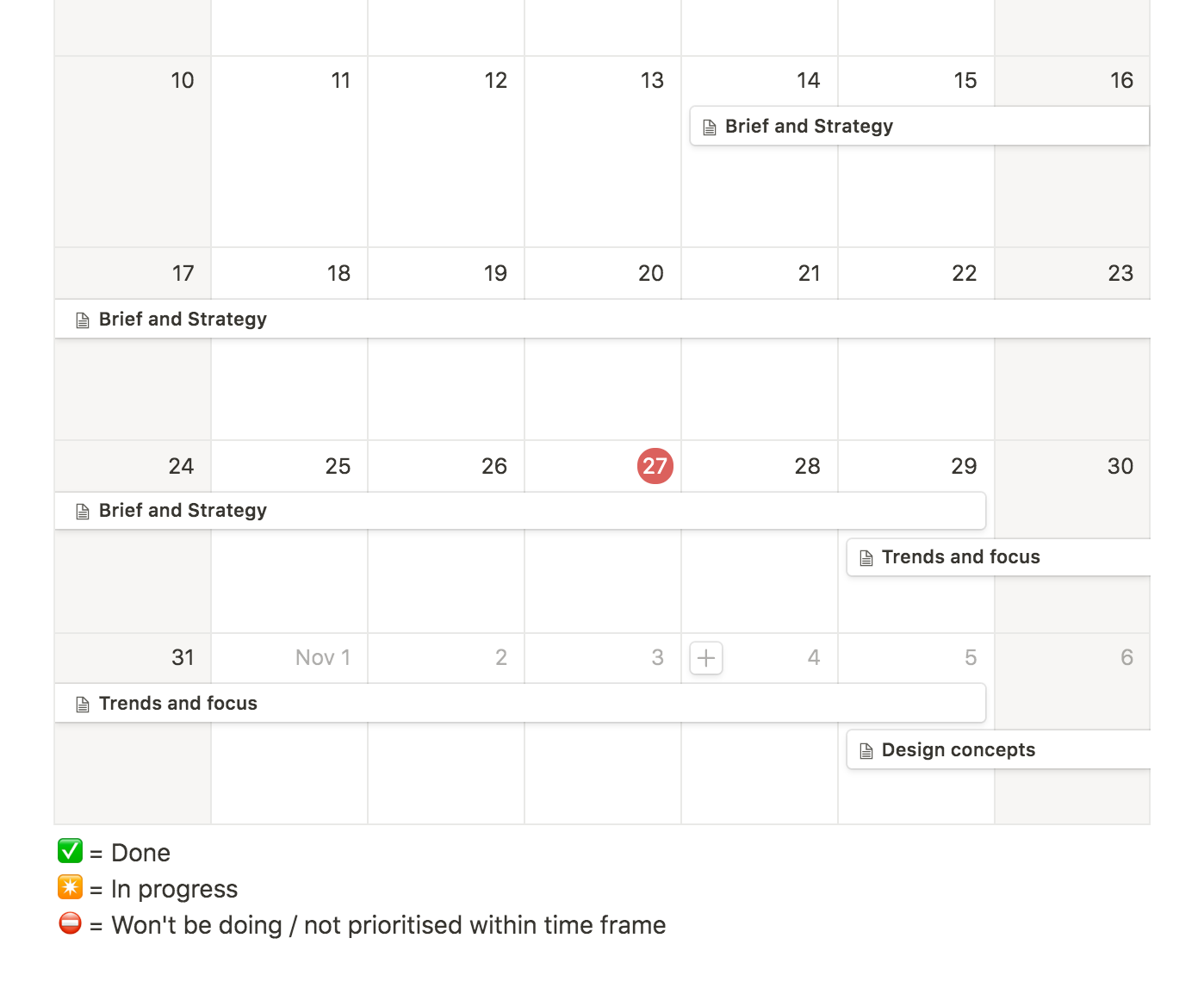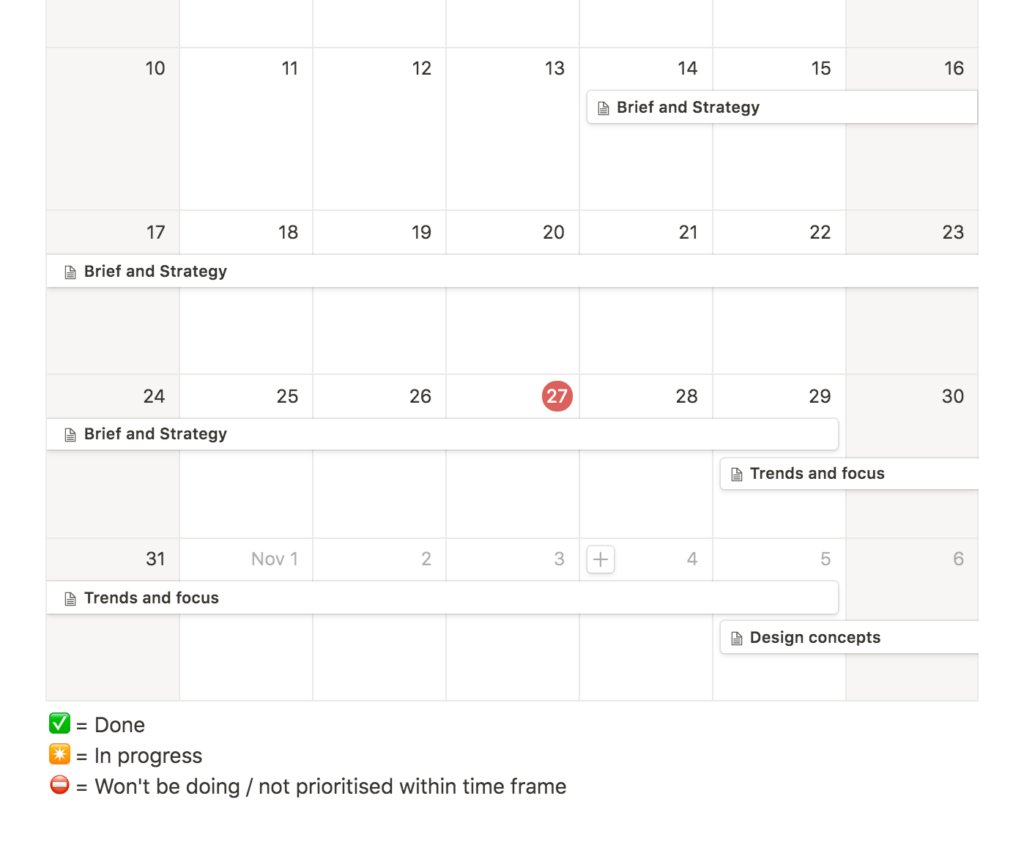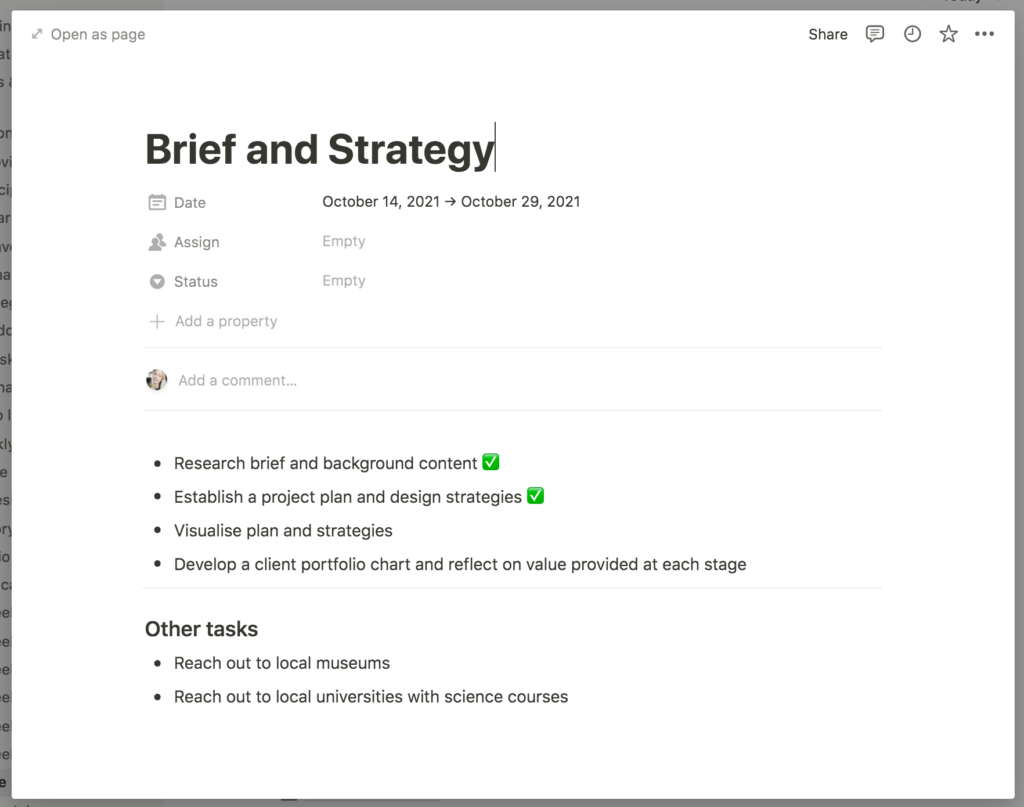Lecture notes
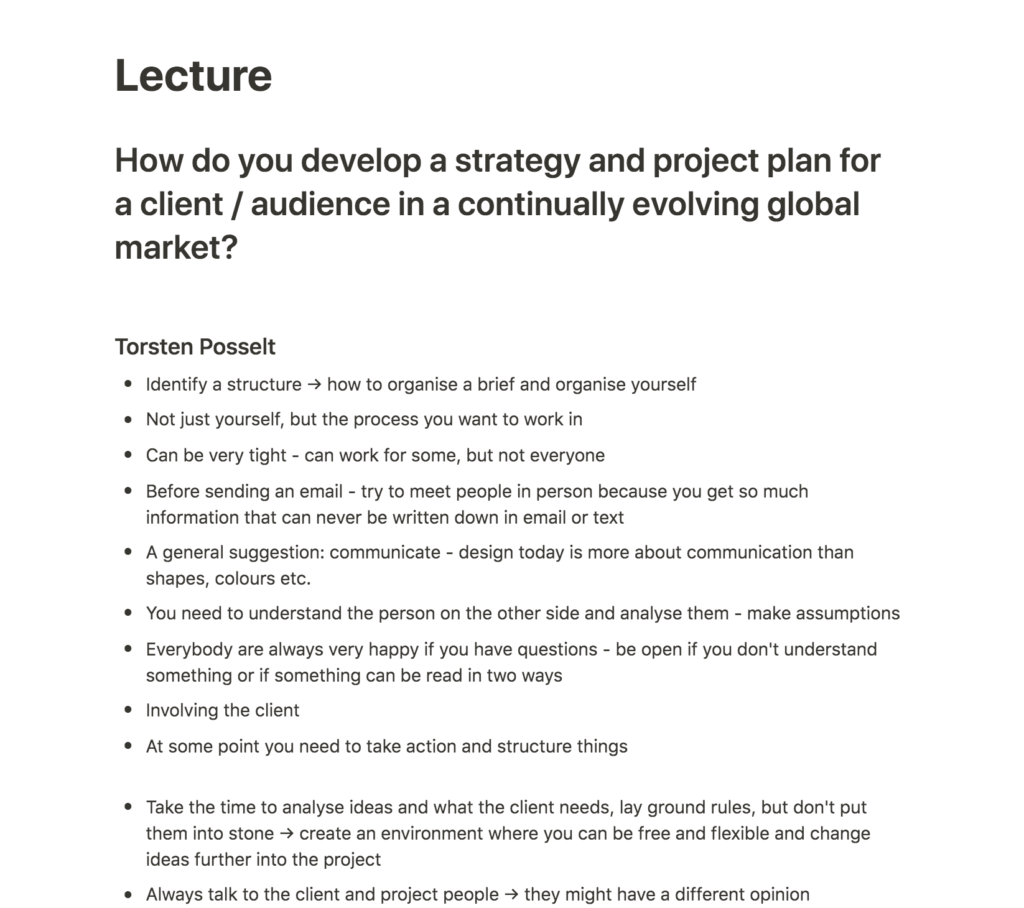
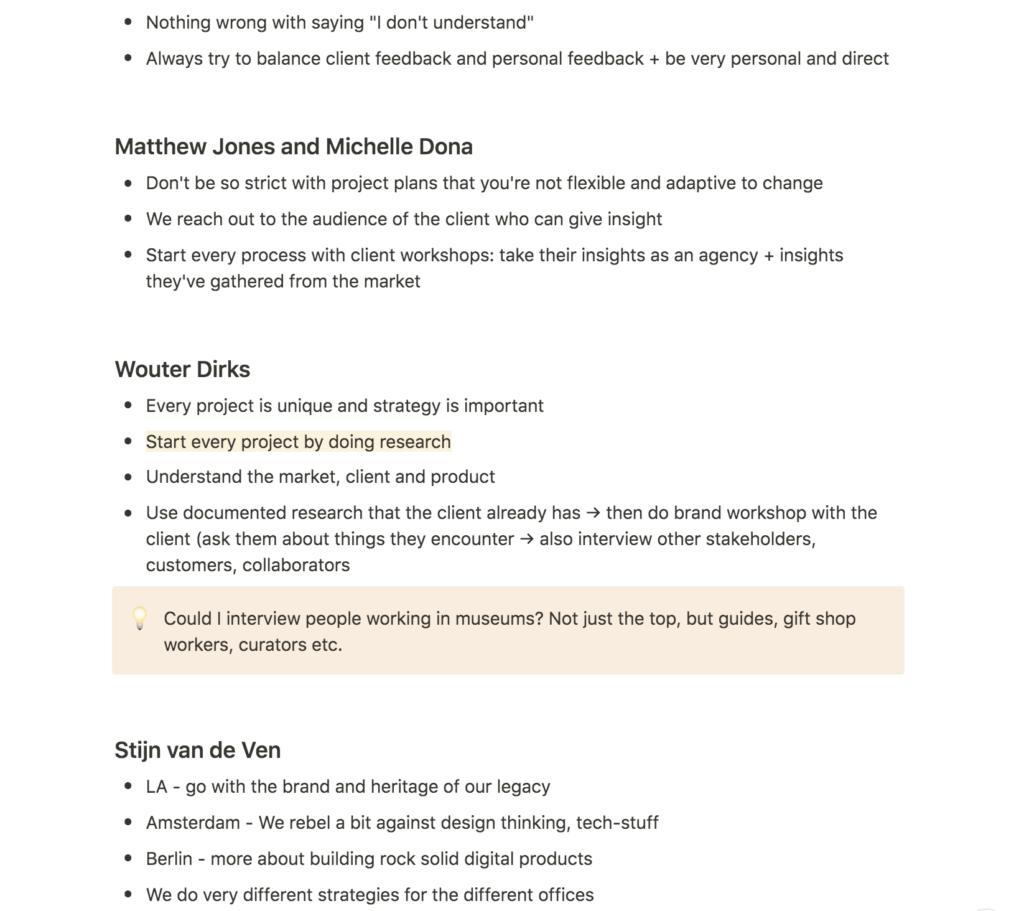
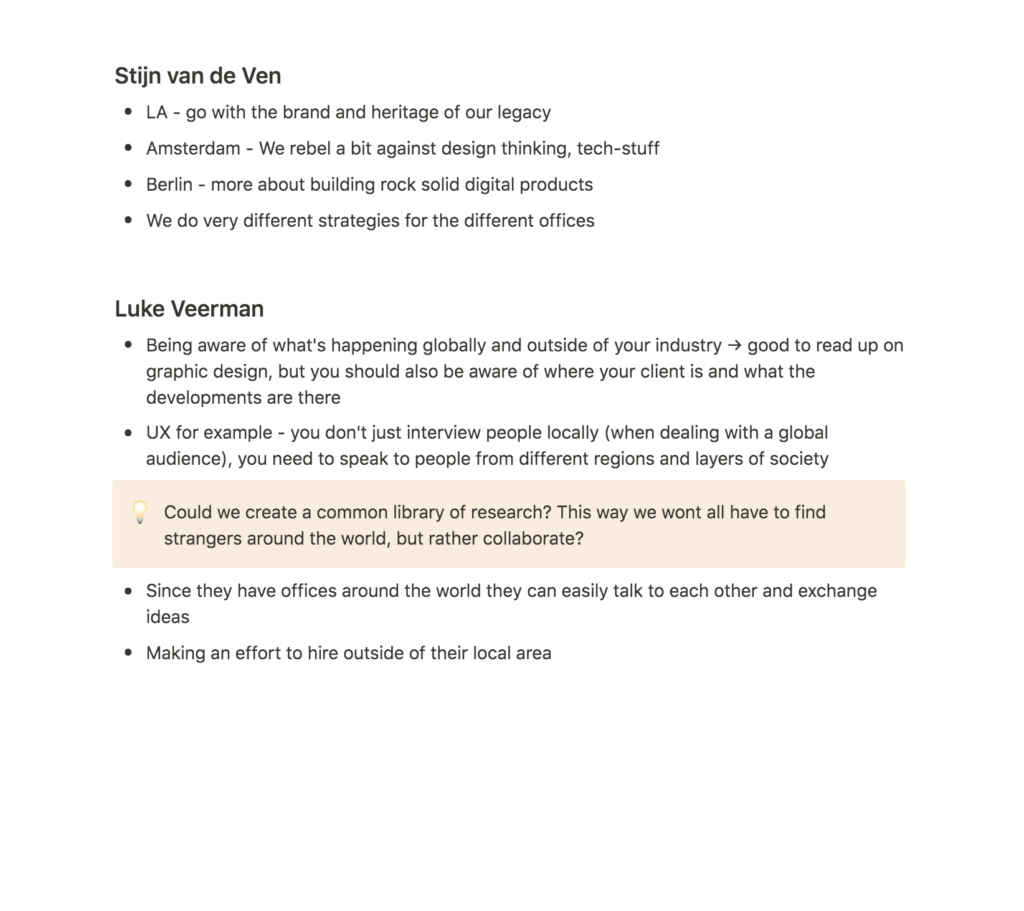
Lecture reflections
A fluid strategy
Torsten Posselt’s discussions this week were helpful as they made me realise that part of making a structure is to plan your design process (Torsten Posselt et al., 2021). I also liked what he said about laying ground rules which are not set in stone (Torsten Posselt et al., 2021). We are only in week 2 of this project, and since we haven’t worked on concept development yet, I think it’s important that the design strategy is sort of fluid and a flexible document. This point was also raised by Michelle Dona (and later in the reading material).
Start with research
Wouter Dirks explained how he always started his strategy work by doing research (Torsten Posselt et al., 2021). In this regard I’m very lucky to have chosen the Science Museum brief because it holds a huge amount of research done by the museum. Following Dirks’ method, I should start this week by analysing this research, and then attempt to interview museum customers, guides, curators, etc. I’m not sure where I would get hold of these people, but it could be worth considering as a way of adding to the museum’s research.
Further, Luke Veerman’s discussions on the sharing of information between offices made me wonder wether we as a course could work together in order to gain a global perspective. It would be quite hard to collect audience research from around the world as individuals, but if everyone working on the brief could share insights somehow, we might begin to understand what the global audience could look like.
Resource notes
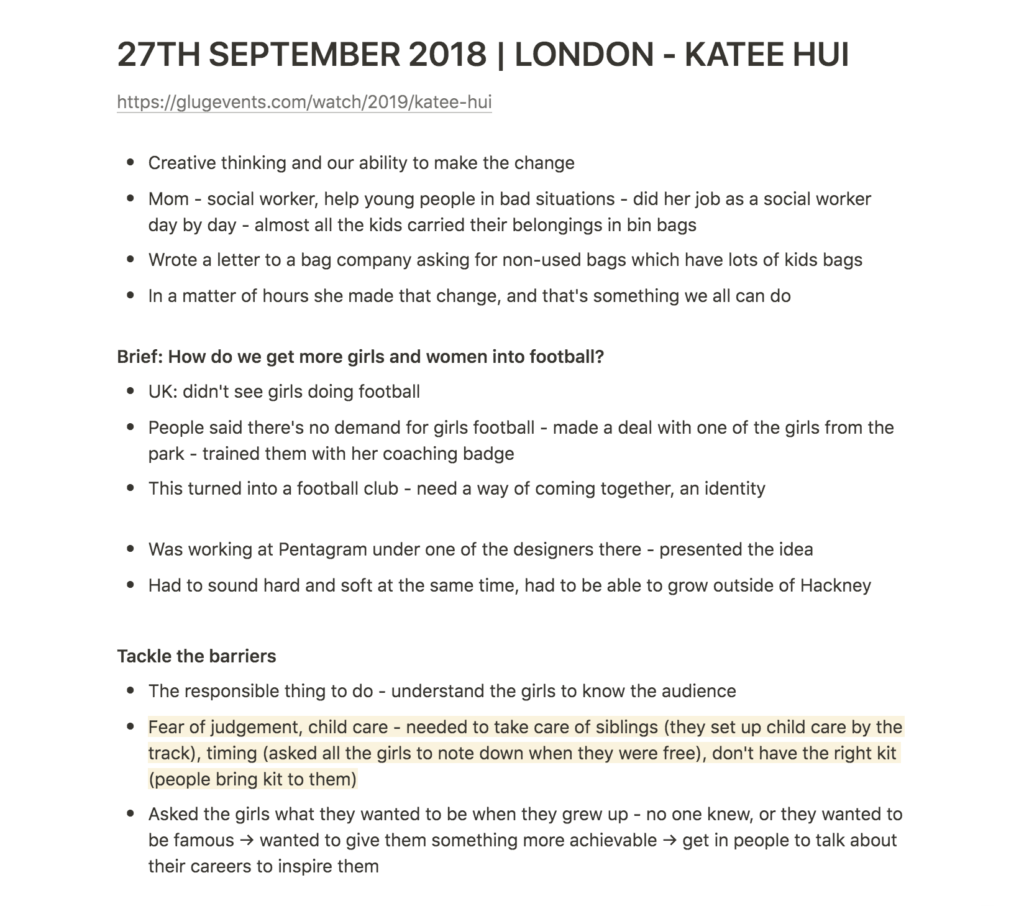
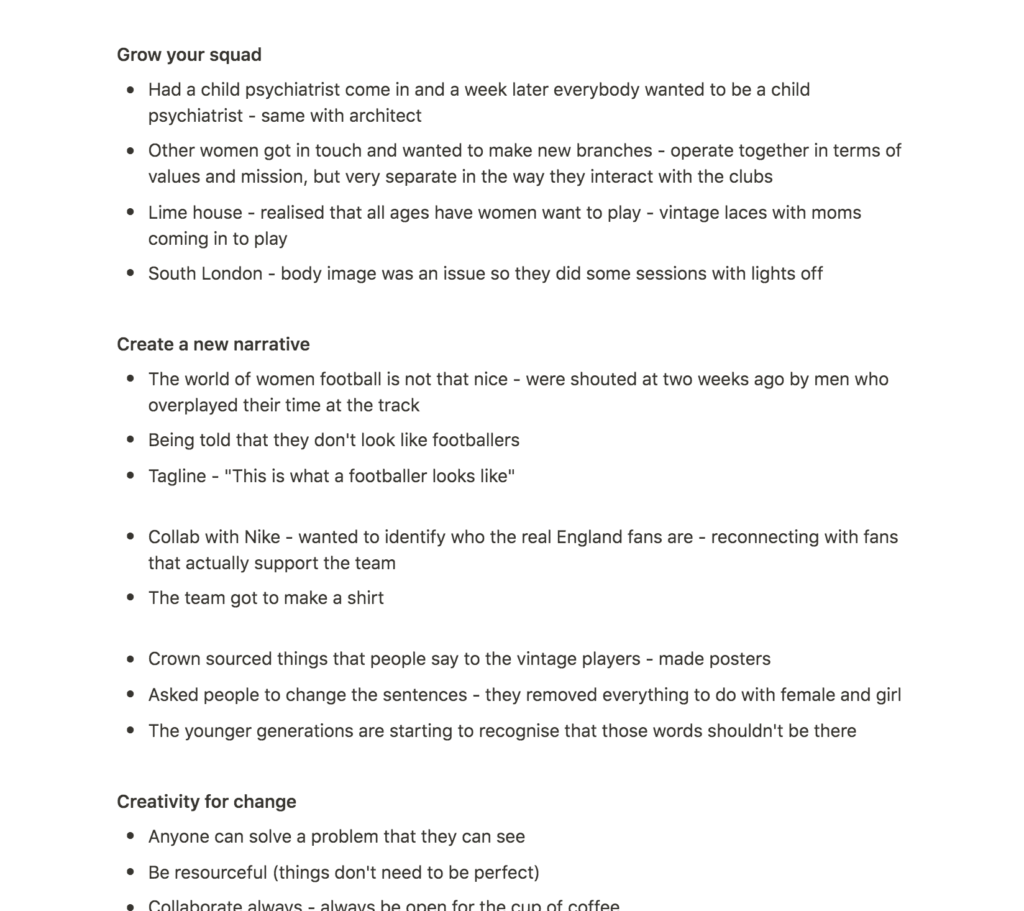
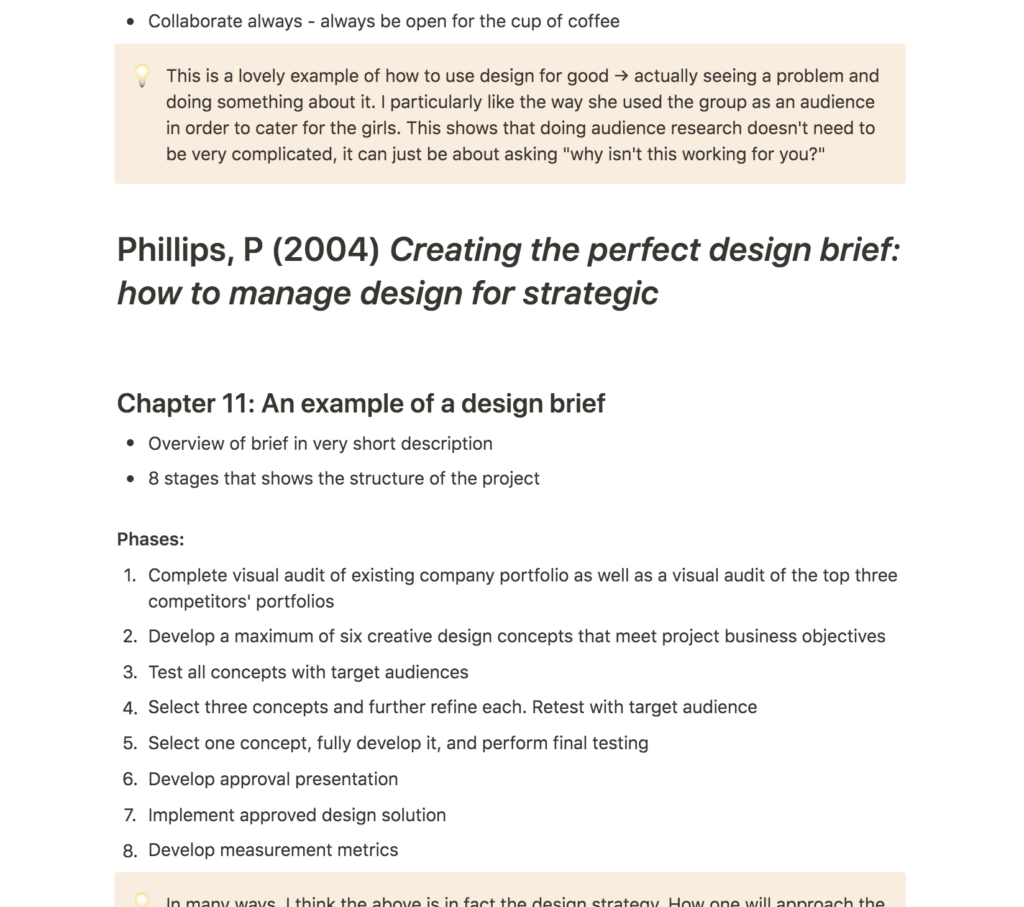
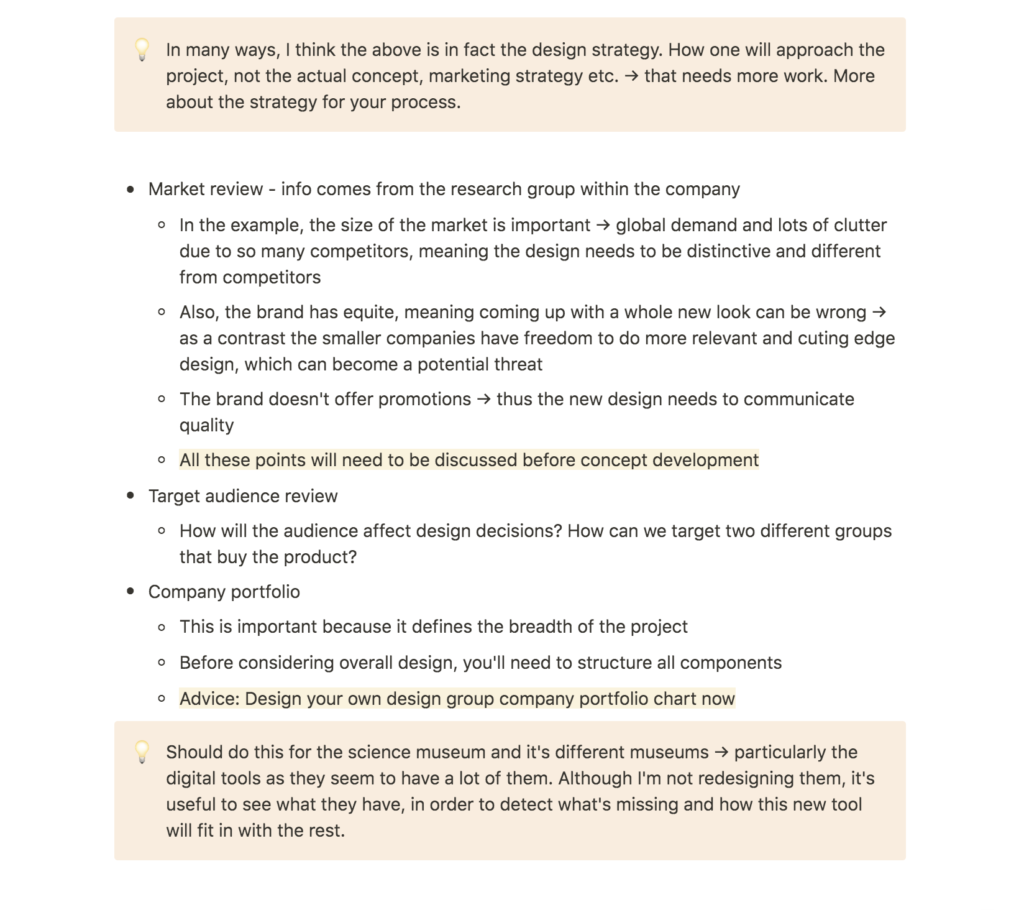
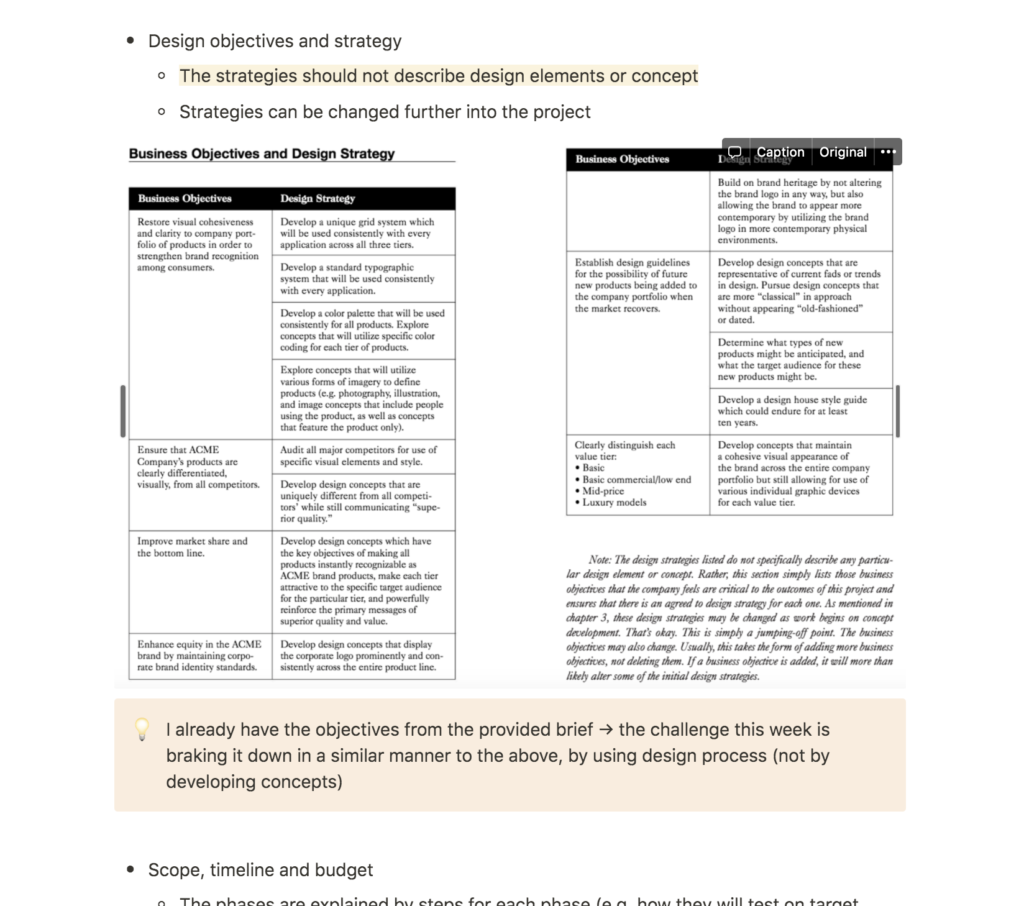
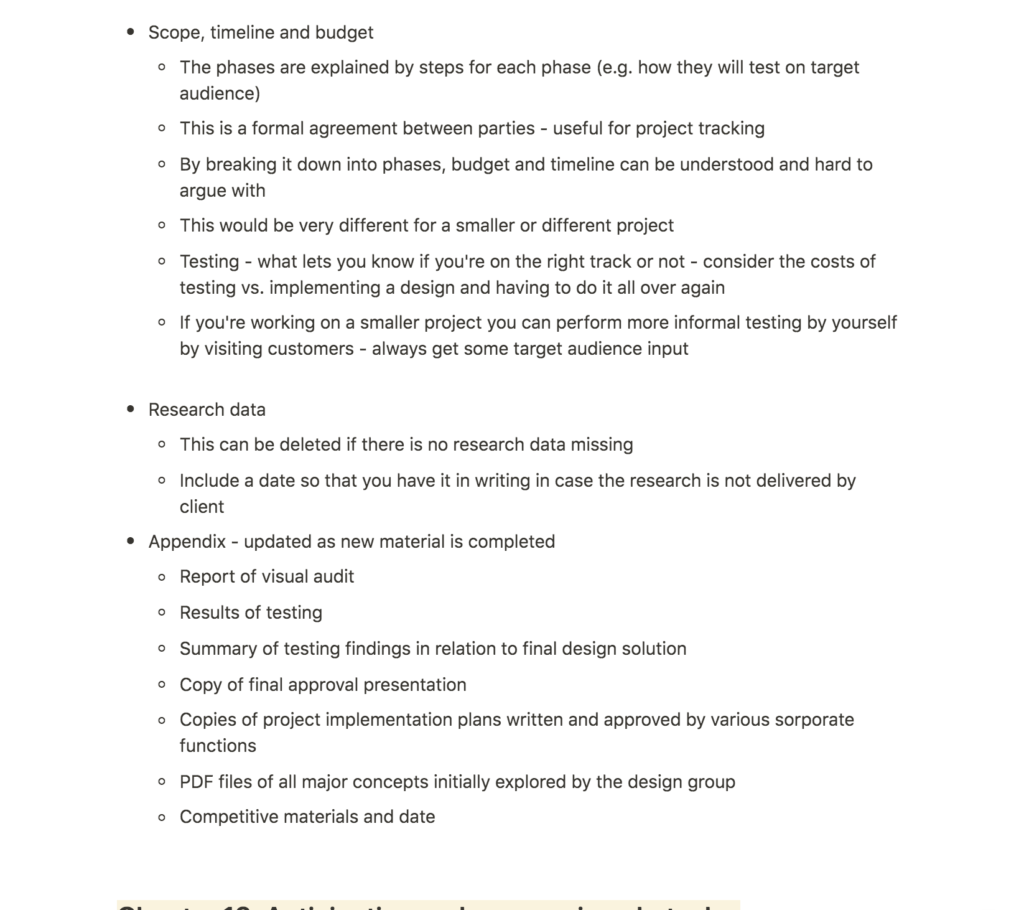
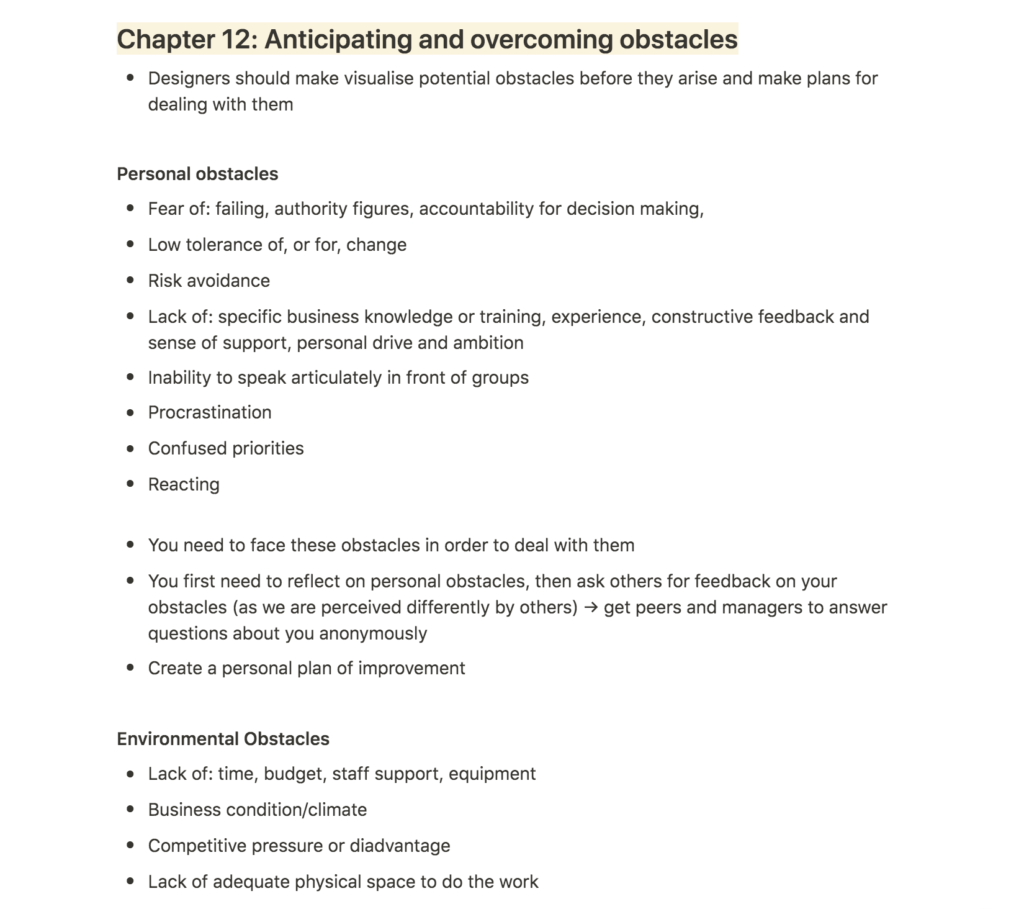
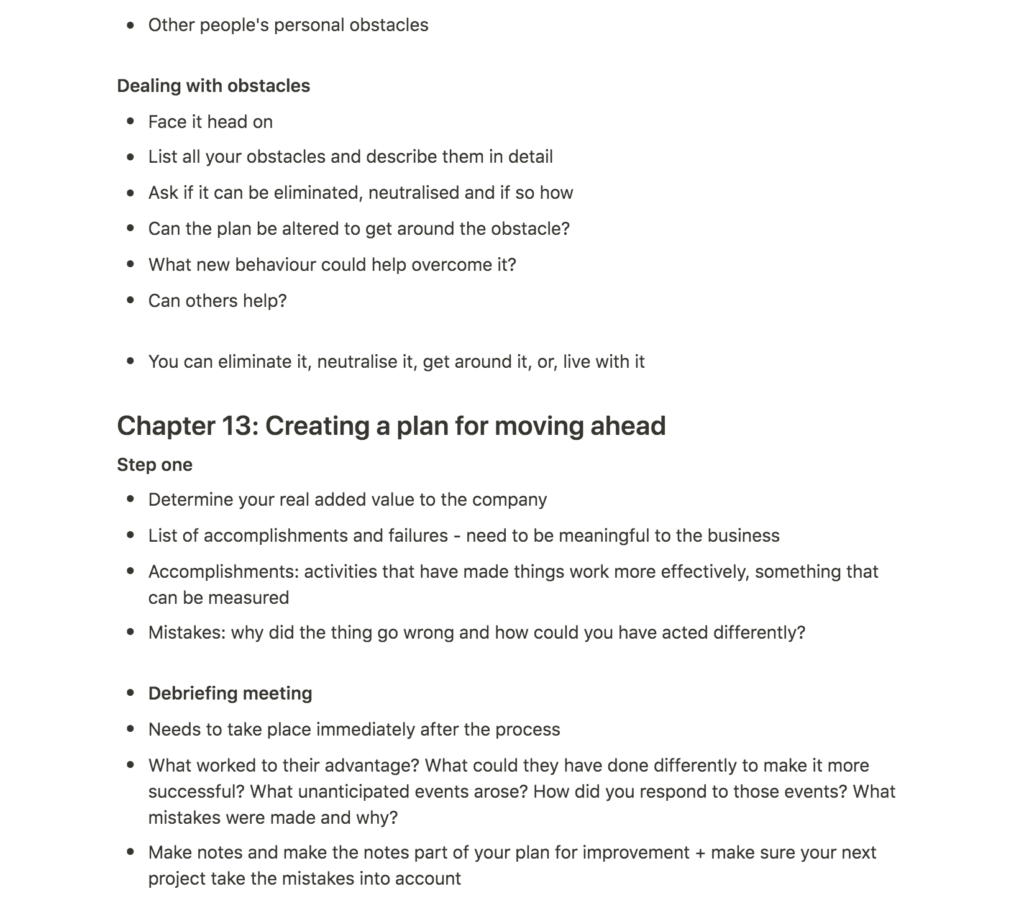
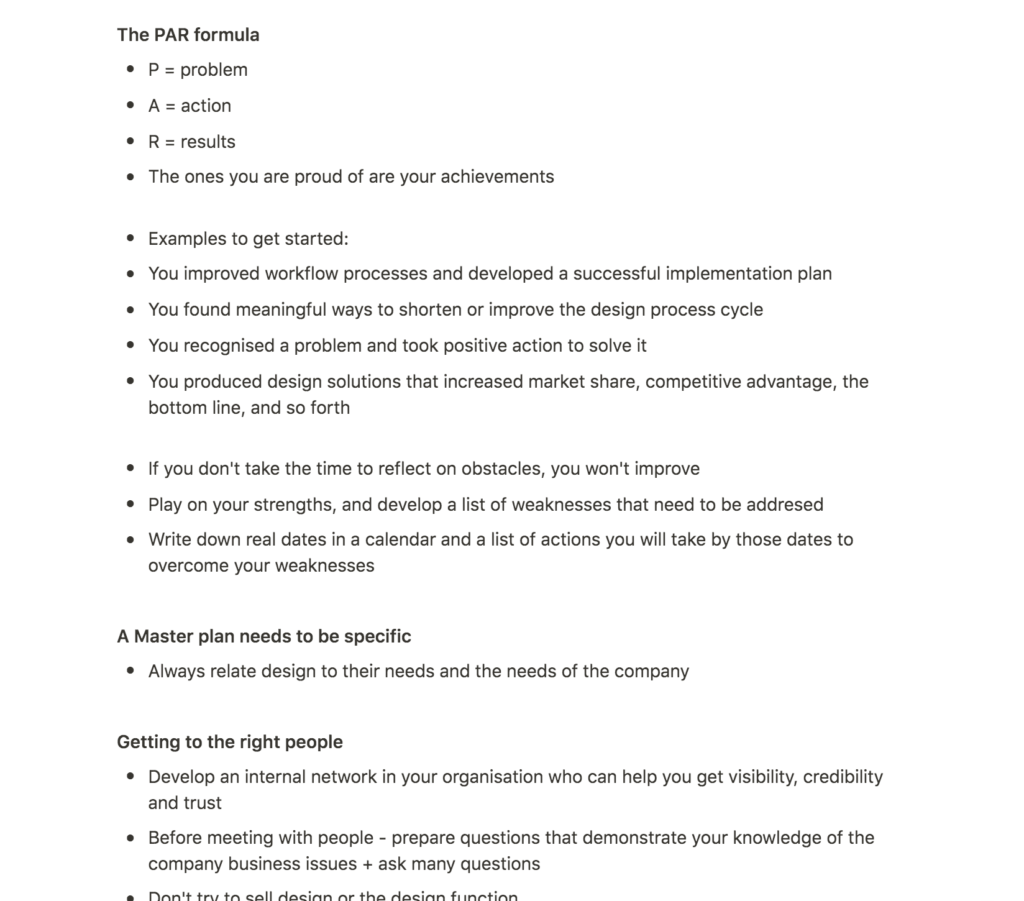
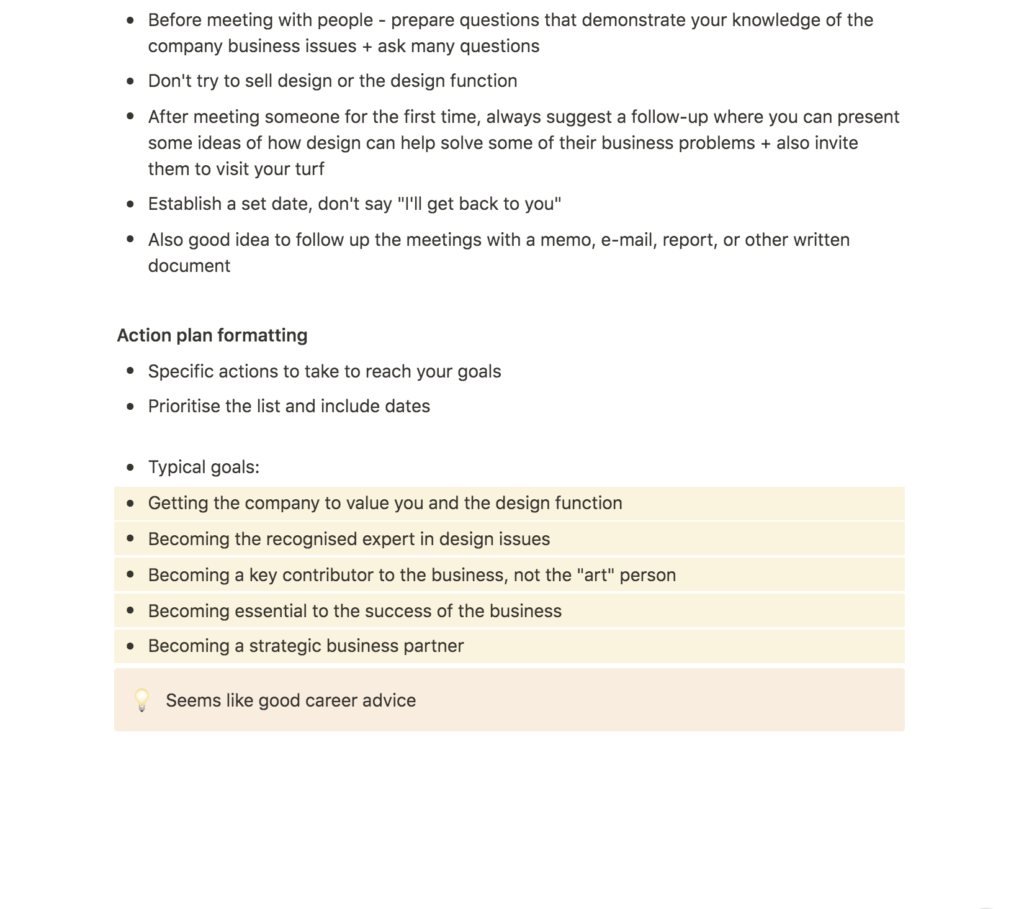
Resource notes
Glug London: Katee Hui
Hui’s talk was very inspiring and a great example of how one can use design for the good by seeing a problem and doing something about it. What I liked the most about her initiative was how uncomplicated she made it seem. Solving an issue doesn’t always need to be about hyper technological solutions. With her “audience research” for example, Hui simply asked the girls why they found it difficult to do football, and then she catered to the issues with very simple solutions like bringing siblings to the track (Katee Hui, 2019).
I can often feel intimidated by doing audience research – I’m not a fan of asking people for their time, and I don’t particularly enjoy the role of an interviewer. However, this was an important reminder of how simple audience research can actually be, and I hope that Hui’s approach can be helpful in the future.
Creating the perfect design brief: how to manage design for strategic advantage
Re-reading Phillips’ example brief was very helpful as it made me understand more about design strategy. In many ways, I got the impression that the phases (design process) is a big part of the strategy itself. By planning your project you begin to plan your strategy for conducting research, developing concepts and implementing your final solution. However, I assume that this is what will go into the project plan, referring to this week’s challenge.
Of course, the Business Objectives and Design Strategy seems like the most important section of the reading material. Seeing the table made me understand how one can use the objectives stated in the brief, and turn them into design strategies by reflecting on what methods you could use to solve them. Phillips’ notion of strategy not describing design elements or concepts (Peter Phillips, 2004) was an important reminder as there seems to be a fine line between these elements.
I was quite fascinated by Phillips’ discussions on designing a company portfolio chart. The Science Museum already have so many digital (and physical) services, and I think laying them all out in order to see how my project can fit in with the rest (Peter Phillips, 2004). I might attempt to adopt this method as I go on to analyse the brief material further this week.
Workshop challenge
Brief notes and analysis
As mentioned in my lecture reflections, I wanted to look further into the provided brief research material before starting the workshop challenge task. I did that by creating a Notion document where I created individual pages for each research document. The Notion document can be seen here.
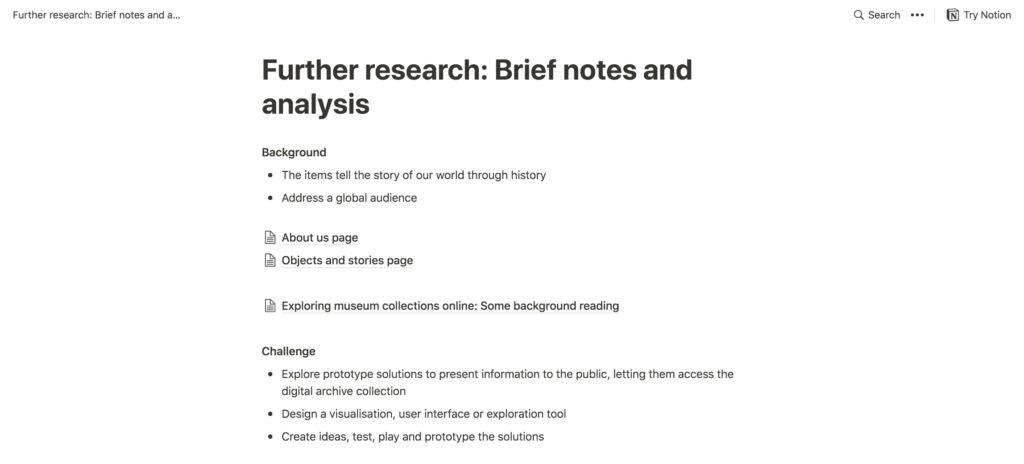
Fig. 2: Reigstad 2021. Notion: brief notes and analysis
I was happy to see that the museum had collected a range of target audience research – in terms of personas, but also in terms of needs and wants on their websites. I was particularly interested in the difference between “snackers” and “vultures” – this indicates that the interface needs to be flexible in terms of amount of information provided.
Although the brief is open to physical solutions, the audience research material did make me feel as if they are looking for a digital solution. In the provided Medium article, How audiences discover the Science Museum Group Collection, I also discovered a range of objectives that the museum had developed related to the project. Inspired by Phillips’ objectives and strategies table, I decided to embark on my own table, as an initial start to the challenge:

Project plan and strategy
After reflecting upon objectives and strategies, I went on to work on the overall project plan and strategy document.
I saw on the ideas wall that Courtney had set up her own padlet board for her project. I was very inspired by her structured approach, and it gave me an idea of setting up a live document of my own. I’m quite familiar to Notion as I use it for personal projects and at work. I therefore thought this would be a good application to use. Notion has a range of features, such as texts, pages within pages, timelines, calendars, tables etc. These functions were very handy once I started to write my project plan and strategy document.
Click here to access my live brief document.
Click here to access a copy of the document, for insight on what the document contained in week 7.
Overview
Although it wasn’t asked for in the workshop challenge task, I wanted my document to include a short overview-text, inspired by Phillips’ example brief. The intentions for the overview were to: 1: attempt to summarise the brief, as a way of understanding what the most important take aways were, and 2; develop an overview of the brief objectives that I could keep coming back to, in order to stay on track throughout the project.
The writing in itself was inspired by and partly copy pasted from the brief and brief material.
Timeline
In order to develop the timeline, I attempted to combine the theories of the double diamond with Phillips’ stages, but also the titles of the module weeks in Canvas.
The Notion document was very handy here, as the timeline lets you open each entry as an individual page. That meant that I could view entries in the timeline or calendar mode, whilst also clicking on each entry for details on what each entry entails:
By reflecting on my personal obstacles (as I’ll get into further below), I realised that the timeline will be an important tool for handling stress, staying motivated, and dealing with lack of time.
I know that I can sometimes take on too much work / be too ambitious with my projects, which causes stress, which again causes lack of motivation and hinders creativity. In order to stay sensible throughout, I created an icon system that lets me mark points that I won’t be prioritising (as well as in progress and finished points). I think having the icons/system in place could be a an important reminder to prioritise and not take too much on.
Objectives and design strategies
As mentioned above, I decided to create a table of objectives and strategies, inspired by Phillips. I established the four objectives by attempting to summarise information from the various brief documents, which led to:
- Create an interface that encourages meaningful browsing, with content that inspires and surprises users
- Target two different personas: “vultures” and “snackers”
- Create an interface that shows the breadth and diversity of the digital collection
- The tool/product-pages can be users’ first interaction with the museum. The final product should therefore represent The Design Museum both in terms of aesthetics and concept.
As discussed in my resource reflections, I didn’t want to establish any design concepts at this stage, but rather an overview of research areas and directions to explore moving forward.
Obstacles and action points
Phillips’ discussions on obstacles were interesting, and I personally felt familiar with a range of them. I thought his way of dealing with them sounded smart, and I therefore decided to include a list of potential obstacles, accompanied by action points in my document.
I noticed that a lot of my obstacles had to do with my own mentality. There is no quick fix this, but I did attempt to establish some action points like “taking breaks when feeling stuck”, “prioritising, rather than working too much” and “exercising”.
One point that I was actually able to adopt my plan for was my lack of target audience contacts. Finding people to interview is a big challenge for me, but by noting down the obstacle I realised that I could try to get in touch with universities and local museums, rather than depending on my personal network. I worked this into my timeline, as an attempt to deal with the obstacle.
Having finished my workshop challenge document, I was starting to wonder wether the Notion document itself could be the final outcome this week. I saw that others posted these beautiful PDFs with their plans, but since I had developed a flexible document that I could keep adjusting throughout the project, I didn’t really think an InDesign-document/PDF would suit my planned way of working.
I decided to ask the tutors on the ideas wall for feedback on this issue, and received an answer from Ben that we could interpret the workshop challenge to suit our own project. This made me decide on sticking to the Notion document as a final outcome.
Five slide presentation
In addition to the project plan, the workshop challenge also asked for a five slide presentation on the rational behind the project plan and design strategy.
Five is a low amount of slides and I interpreted this limitation as an indication that our presentations should be brief and to the point. Since my plan consisted of four sections (overview, timeline, objectives and strategy, and obstacles), I thought the best way of structuring the presentation would be to using these as slide themes.
Having established a structure I went on to write a script and eventually record my video presentation:
Further research
Target audience development
Having finished the workshop challenge with some time to spear, I decided to get on with the next to-do points as established in my timeline.
Finding my audience
Since one of my obstacles was that I struggle with getting in touch with target audiences, I decided to look for potential candidates for interviews and testing. I knew that the University of Oslo had several courses on science, and I therefore started looking for lecturers and PhD candidates.
Since The Science Museum offers objects within a range of fields (e.g. history, art, science etc.), I wanted to find people from a range of backgrounds. On one hand, I was interested in learning about how science lecturers research. On the other, I also wanted to talk to lecturers within more creative fields such as literature and aesthetics. By combining insights from different fields, I could potentially understand more about different modes of research, as noted down in my design strategies.
Point of interview
I managed to find some interesting people to contact from the university, and I also established a few personal contacts I could talk to, who were more typical “snackers”. However, as I researched I realised that I was unsure on what I would actually talk to my audience about. I already knew what the museum wanted (a browsing tool), and I also had quite a bit of information on audience behaviour from the provided brief material.
I decided to reflect on the issue with my partner, who’s a UX-designer with more experience on user interviews. Together we discussed that at this point in time, I might better off spending my time doing research, and perhaps some expert interviews, as audience interviews could lead to very broad insights due to the lack of project focus. Then, when I have a few concepts ready, I can reach out to the audience I had found at the university.
Since I wanted to prioritise expert interviews, I went on to research academics and research groups connected to Museums and Museology at UiO (University of Oslo).
Housing heritage: exploring, theorising and problematising multiple kinds of heritage making
Looking through the staff pages at the University of Oslo, I discovered an interesting research group: Housing heritage. The research group looks at the processes of making heritage in institutions like museums, ministries and directorates (Gro Ween, 2019). Their article/about-page was fascinating and made me reflect on how museums’ narratives of objects are connected to history and the way we display different heritages. This made me wonder how we can display authentic/”correct” narratives, but also how we can develop systems that lets viewers explore different narratives that relate to the same object, in order to start questioning our history and the different perspectives of the world.
I was also interested in the following questions, raised in the article: “How exactly should heritage be kept, for what purpose, and for what kind of futures?” (Gro Ween, 2019). Moving on to next week I think these are very interesting questions to ask. Today, museums face issues related to colonialism and how objects were once collected (as discussed by Ben in this week’s lecture). What issues will archives and museums face in the future, and could we potentially develop interfaces that cater to these issues?
Museum: A Culture of Copies
In my UiO research I also read about the research project, Museum: A Culture of Copies, which I later discovered had turned into a book. The research project looks at digital representations in museums, and how this will affect the museum’s place in society (Brita Brenna, 2020). I particularly liked this quote from the website: “The museum (…) has provided a space for multifarious representations – within this space it creates “the real” through copying practices” (Brita Brenna, 2020).
Again, I was intrigued by the idea of creating “the real” as a narrative of history. I also think the discussions on copies was a fascinating issue, especially in light of Ben’s lecture this week, where he discussed how certain art works has to be presented with specific materials and technology.
I was very fascinated with the two projects above, and I think the researchers behind them would be great candidates for expert interviews. However, I wanted to process the information before getting in touch and taking their time, and so I noted down their names for next week.
In conclusion
Working on this week’s challenge has felt very pragmatic, which isn’t necessarily something I usually opt for. However, it’s been rewarding to make a plan before going into a project, as I do feel like I have more control than I’d normally have. I think that identifying my personal obstacles will help me as I move forward with the project, and it will be interesting to measure the extent of this help at the end of the module.
Not creating a glossy and finished PDF for my plan is slightly unlike me, as I tend to enjoy the design aspects more than the writing. However, I’m quite happy with my decision of sticking with my live Notion document. This type of document will serve value to me throughout the project as I can actually use it, as apposed to what I could do with an exported PDF.
If I had more time this week I would have liked to do more research into design strategies and the process of developing them. My current strategies are very much based on how Phillips creates his, and with more research I might have been able to develop a more detailed and informed overview. I also would have liked to do more research, and perhaps choose a focus for my project. At the end of the week I found some interesting resources, and moving on to next week I would like to continue my research, in order to narrow down my project – for example by arranging expert interviews.
REFERENCES:
Brita Brenna (2020) ‘Museum: A Culture of Copies’, University of Oslo. Available at: https://www.hf.uio.no/ikos/english/research/projects/a-culture-of-copies/ (Accessed: 29 October 2021).
Gro Ween (2019) ‘Housing heritage: exploring, theorising and problematising multiple kinds of heritage making’, University of Oslo. Available at: https://www.khm.uio.no/english/research/research-groups/housing-heritage/index.html (Accessed: 29 October 2021).
Katee Hui (2019) Glug London: Katee Hui. Available at: https://www.youtube.com/watch?v=HjsrrWzQMKQ&ab_channel=GlugEvents%E2%80%94TalksandNotworking (Accessed: 23 October 2021).
Peter Phillips (2004) Creating the perfect design brief: how to manage design for strategic advantage. New York: Allworth Press.
Torsten Posselt et al. (2021) ‘How do you develop a strategy and project plan for a client / audience in a continually evolving global market?’ Canvas Falmouth Flexible [online], 22 October.
LIST OF FIGURES:
Figure 1: Katee HUI. 2019. Glug London: Katee Hui
Figure 2: Ingrid REIGSTAD. 2021. Notion: brief notes and analysis. Private collection: Ingrid Reigstad.
Figure 3: Ingrid REIGSTAD. 2021. Notion: strategy process. Private collection: Ingrid Reigstad.
Figure 4-5: Ingrid REIGSTAD. 2021. Workshop challenge week 6 document. Private collection: Ingrid Reigstad.
Figure 6: Ingrid REIGSTAD. 2021. Workshop challenge week 6 presentation. Private collection: Ingrid Reigstad.
